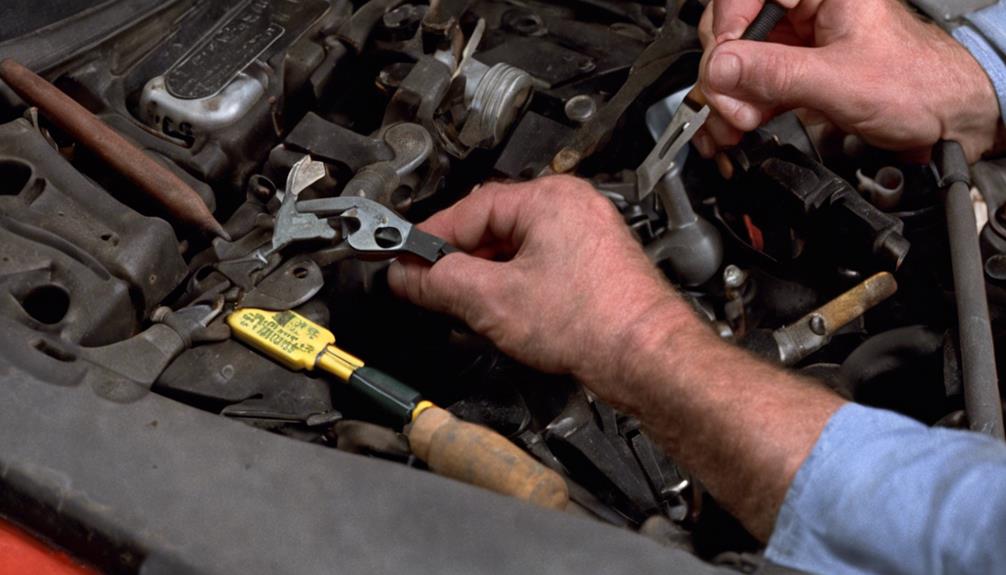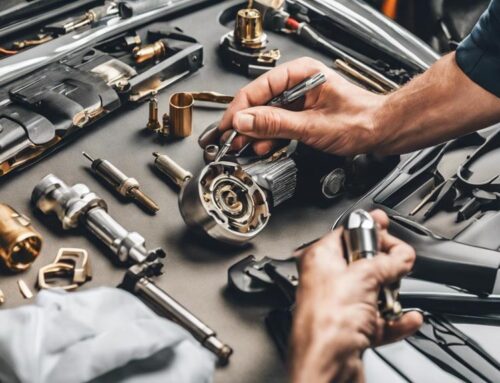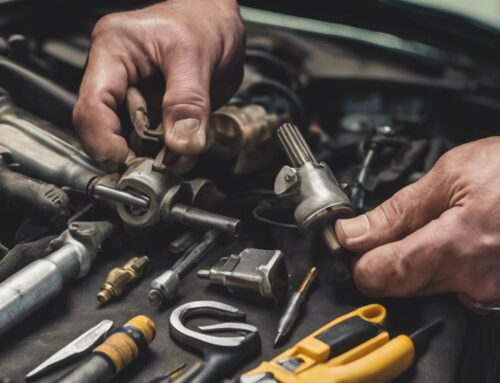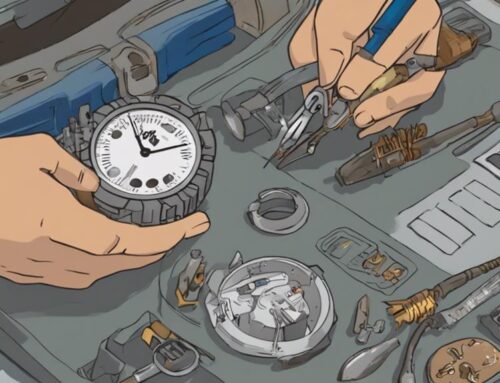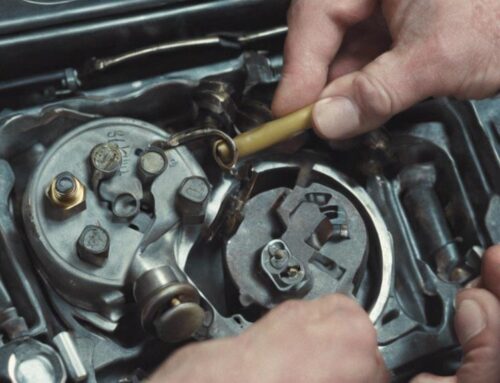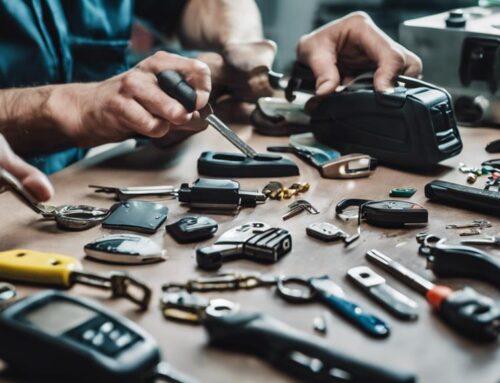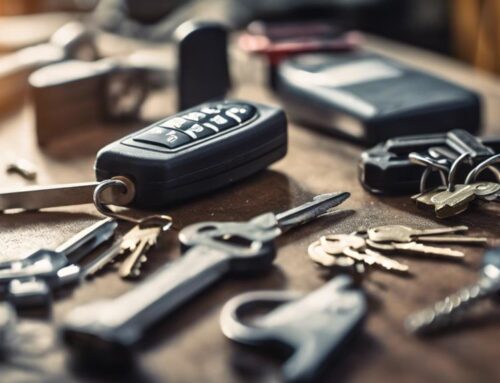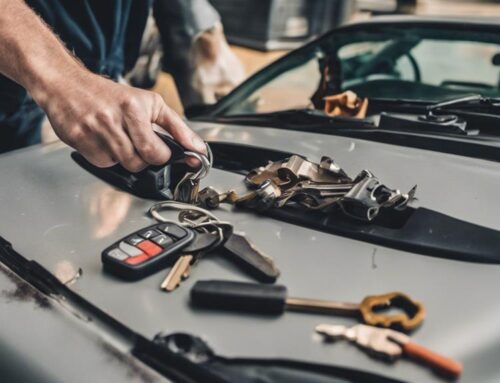When you think about repairing or replacing an ignition switch, it's vital to take into account the right tools and methods for the job. You'll need basic items like screwdrivers and socket sets, but specialized tools can make a substantial difference, especially for older vehicles. The process isn't just about swapping parts; it requires careful assessment of compatibility and dimensions. So, what specific steps do you need to follow, and how do you guarantee everything fits seamlessly? Understanding these factors can be essential for a successful repair, particularly in vintage models.
Key Takeaways
- Essential tools for ignition switch repair include screwdrivers, socket sets, wire strippers, and locksmithing tools for key extraction and handling.
- The replacement process involves disconnecting the battery, removing the steering column cover, and accessing the ignition switch.
- Testing the new ignition switch is crucial to confirm proper functionality before final assembly and reconnecting the battery.
- Compatibility with older vehicles requires assessing electrical systems, measuring switch dimensions, and ensuring key mechanism alignment with existing keys.
- Professional services can ensure effective diagnosis, access to quality parts, and efficient repairs for ignition switch issues in vintage models.
Overview of Ignition Switch Issues
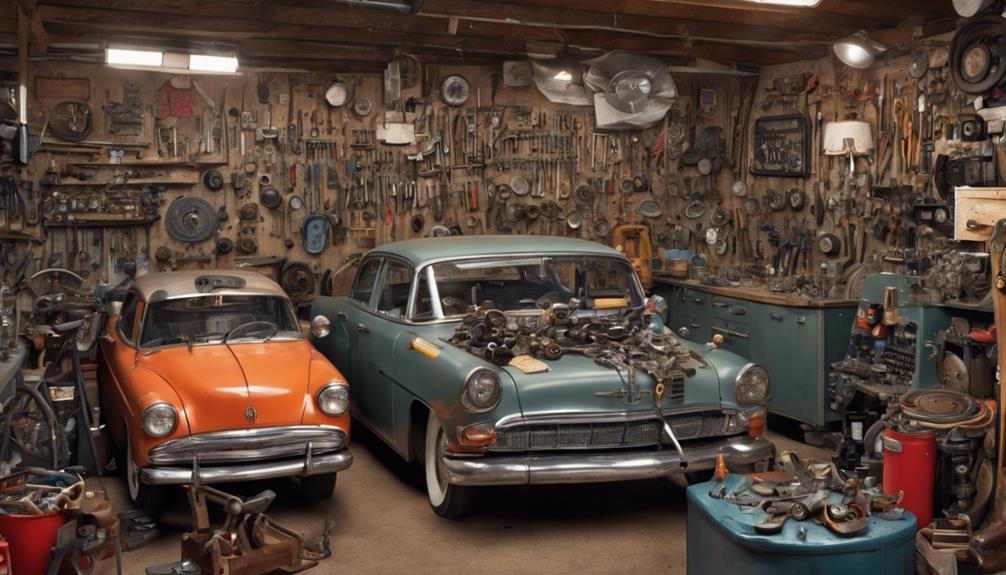
Ignition switch issues can affect a significant number of vehicles, leading to various problems that impact drivability and safety. When you experience ignition problems, it often stems from a switch malfunction that disrupts the electrical flow necessary for starting your engine. This malfunction can prevent the ignition system from receiving power, causing frustrating no-start conditions or intermittent power loss while driving. You'll notice symptoms like flickering dashboard lights or failure to start, which may escalate if left unaddressed. Addressing these concerns promptly is essential; otherwise, you risk further damage to your ignition system and potential safety hazards. Understanding the intricacies of these ignition problems empowers you to make informed decisions about repairs or replacements, ensuring your vehicle operates at peak performance. Ignition switch failures can be caused by various factors, such as wear and tear or electrical issues, highlighting the importance of regular maintenance and inspections to prevent potential safety hazards.
Common Tools Used by Locksmiths
When you're tackling ignition switch issues, having the right tools is vital. You'll need essential locksmithing tools, along with specialized ignition tools that streamline the repair or replacement process. Don't overlook safety equipment, as it guarantees both your protection and the integrity of the vehicle.
Essential Locksmithing Tools
A locksmith's toolkit is essential for efficiently addressing various lock and key issues, including ignition switch repairs. Mastering locksmith techniques for ignition troubleshooting requires the right tools. Below is a table highlighting common locksmithing tools you should have:
| Tool | Purpose |
|---|---|
| Lock Pick Set | For manipulating lock pins |
| Tension Wrench | Applies torque to the lock |
| Key Extractor | Removes broken keys from locks |
| Screwdriver Set | For disassembling ignition systems |
Each tool plays a critical role in diagnosing and repairing ignition switches. Having these tools at your disposal empowers you to tackle complex ignition problems with confidence and efficiency, ensuring a reliable solution for your vehicle's ignition system.
Specialized Ignition Tools
Mastery of specialized ignition tools is essential for locksmiths focused on effective ignition switch repairs. You'll need a variety of specialized equipment to tackle complex ignition diagnostics. Essential tools include a dedicated ignition switch removal kit, which allows for precise disassembly without damaging surrounding components. A key code machine is invaluable for creating replacement keys when necessary. Additionally, a multimeter aids in diagnosing electrical issues within the ignition system. Using these tools, you can efficiently pinpoint faults and restore functionality. Investing in high-quality equipment not only enhances your skill set but also empowers you to handle a broader range of vehicles, including older models, ensuring that you're always prepared to meet client needs with confidence.
Safety Equipment Necessities
Safety equipment is vital for locksmiths working on ignition switches, guaranteeing protection from potential hazards. When you tackle ignition repairs, prioritize personal protective gear like gloves and safety goggles. These items safeguard you against sharp edges and harmful debris. Additionally, using a sturdy workbench prevents accidents and keeps your tools organized.
Implementing safety precautions is important; make certain your workspace is well-lit and free from clutter to minimize risks. A first-aid kit should always be within reach for emergencies. Consider using a voltage tester to confirm that the electrical system is deactivated before starting any work. By equipping yourself with the right safety tools and maintaining awareness, you'll enhance efficiency and protect yourself while executing repairs or replacements on ignition switches.
Step-by-Step Repair Methods
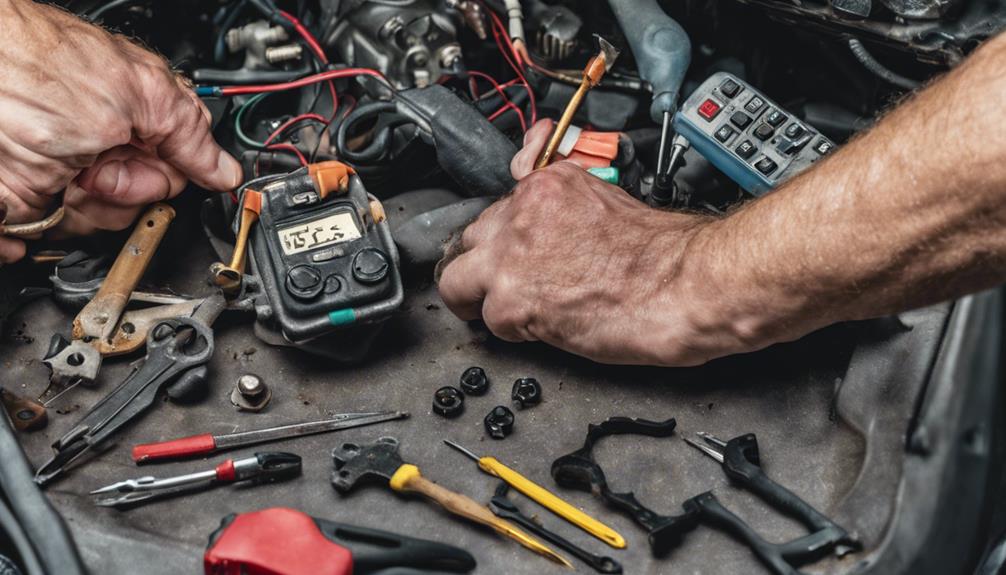
To effectively repair or replace an ignition switch, you'll need specific tools to get started. This guide will outline a step-by-step replacement process while highlighting common issues you might encounter along the way. Understanding these aspects will guarantee a smoother repair experience.
Tools Needed for Repair
Before diving into the repair process, it's crucial to gather the right tools for replacing or fixing an ignition switch. Your tool selection is critical for effective repair techniques. Start with a basic socket set, including metric and SAE sizes, to remove the ignition switch. A flathead and Phillips screwdriver will help with any screws securing the switch. Don't forget the wire strippers and crimping tool for reconnecting electrical components. A multimeter is important for diagnosing electrical issues and ensuring proper function. Finally, a steering wheel puller might be necessary if you need to access deeper components. With these tools in hand, you're well-equipped to tackle the ignition switch repair with confidence and precision.
Step-by-Step Replacement Guide
With the right tools gathered, you can now focus on the step-by-step process for replacing the ignition switch. Start by disconnecting the battery to guarantee safety. Next, remove the steering column cover to access the switch. Identify the ignition switch and disconnect the wiring harness—this is essential for effective ignition troubleshooting. Unscrew the bolts securing the switch in place and carefully remove it. Install the new switch, making sure all connections are secure, and reattach the steering column cover. Finally, reconnect the battery and test the new ignition switch for proper functionality. Regular switch maintenance can prevent future issues, so keep an eye on performance and address any irregularities promptly. You're now empowered to execute this replacement confidently.
Common Issues Encountered
Ignition switches can present various issues that may hinder your vehicle's operation. To effectively address these problems, you need to focus on symptom identification and apply appropriate troubleshooting techniques. Here are three common issues you might encounter:
- No Start Condition: This can indicate a faulty ignition switch or related wiring problems. In some cases, locksmiths may be able to repair or replace the ignition switch Can Locksmiths Fix Ignition Switches in Any Vehicle.
- Intermittent Electrical Failures: If your dashboard lights flicker or accessories malfunction sporadically, it suggests a weak connection within the switch.
- Key Sticking or Jamming: Difficulty in turning the key often points to internal wear or debris in the ignition mechanism.
Replacement Process for Ignition Switch
Replacing an ignition switch involves several key steps that guarantee a successful installation and restore your vehicle's functionality. First, you'll need to identify the ignition switch type compatible with your vehicle, as there are various designs available. Gather the necessary tools, including a screwdriver, socket set, and wiring diagram. Next, disconnect the battery to prevent short circuits. Remove the steering column covers, locate the ignition switch, and detach any connectors. Install the new switch, ensuring all connections are secure. Before final assembly, test the new switch to confirm proper operation. Finally, replace the steering column covers and reconnect the battery. Keep in mind that replacement costs can vary based on ignition switch types and labor rates, so budget accordingly.
Compatibility With Older Vehicles

When considering a new ignition switch, compatibility with older vehicles can present unique challenges. Several ignition compatibility factors must be assessed to guarantee proper function in vintage vehicles. Here are three key considerations:
- Electrical System: Older vehicles often have different wiring standards. Verify the new ignition switch matches the existing system. It's important to understand the electrical system differences to avoid compatibility issues.
- Physical Dimensions: The size and shape of the ignition switch can vary widely. Measure the original switch to assure a perfect fit.
- Key Mechanism: Vintage vehicles may use unique key designs. Confirm the new switch accommodates your existing key or replace it with a compatible version.
Navigating these vintage vehicle considerations is essential for a successful ignition switch replacement that maintains your vehicle's integrity and performance.
Benefits of Professional Services
Choosing professional services for ignition switch repair or replacement offers numerous advantages that can markedly enhance the outcome. First, you'll benefit from cost savings, as professionals can quickly diagnose the issue and prevent further damage, which could lead to more expensive repairs. They have access to quality parts and tools, ensuring the work is done right the first time. Additionally, time efficiency is a major factor; experienced technicians complete repairs swiftly, getting you back on the road without unnecessary delays. You won't have to waste hours troubleshooting or attempting the repair yourself. Overall, opting for professional help not only secures a reliable fix but also optimizes your vehicle's performance and longevity. Understanding the Locksmith Process for Ignition Cylinder Repair
Low Rate Locksmith's Expertise

In today's fast-paced world, having access to a skilled locksmith can make all the difference in resolving ignition switch issues efficiently. Low rate locksmiths not only provide cost-effective solutions but also possess essential locksmith certifications that guarantee their expertise in ignition troubleshooting. Their proficiency allows them to handle a variety of tasks, including:
- Diagnosing ignition switch malfunctions with precision.
- Recommending the best repair or replacement options based on vehicle specifications.
- Utilizing specialized tools to guarantee seamless installation and operation.

